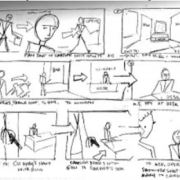Are you a plotter or a pantser?
Do fiction authors fully plan their story before entering the first keystrokes of chapter one? In other words, do they have a clear ‘storyboard’ mapped out chapter by chapter before they allow their creative juices to start flowing?
I’m sure many of them do, but I like to think that many more allow themselves the freedom to be taken where the story leads. I’m firmly in the camp of those who fly by the seat of their pants when it comes to writing. And I make no excuses for it.
Yes, there has to be some kind of pre-planning and pre-plotting, but don’t let anybody kid you into believing there’s an overall formula for writing novels. The plain fact is that there isn’t. Authors are individuals and will do it twenty-ways-from-Sunday differently than the guy next door. It’s good to learn from all the preferred methodologies but there simply isn’t a one-size-fits-all model to help the budding author.
No matter how much or how little planning goes into a story, writers will find themselves stumbling across many scenes which suddenly take them off in different, and unplanned, directions. I promise you, it will add greatly to the story – and to your enjoyment in telling it – if things happen in a way you hadn’t thought about during the pre-planning stages.
The biggest example of the impossibility of pre-planning every crook and nanny of a book can be found in character dialogue. Let me make an admission as a member of the hardboiled action genre – the first book I fell in love with was Jane Austen’s Pride and Prejudice! If you’ve read it you’ll know what I’m talking about, if you haven’t, treat yourself to a literary gem that continues to spawn Holywood film remakes. But I digress. The point I want to make is this: I can see how Miss Austen could have storyboarded (or whatever it is they did back in the early 1800’s) but no way could she have pre-recorded some of the most memorable dialogue you’ll ever come across. Permit me to give one of many examples:
“Miss Bennet,” replied her ladyship, in an angry tone, “you ought to know, that I am not to be trifled with. But however insincere you may choose to be, you shall not find me so. My character has ever been celebrated for its sincerity and frankness, and in a cause of such moment as this, I shall certainly not depart from it. A report of a most alarming nature reached me two days ago. I was told that not only your sister was on the point of being most advantageously married, but that you, Miss Elizabeth Bennet, would, in all likelihood, be soon afterwards united to my nephew, my own nephew, Mr Darcy. Though I know it must be a scandalous falsehood, though I would not injure him so much as to suppose the truth of it possible, I instantly resolved on setting off for this place, that I might make my sentiments known to you.”
“If you believed it impossible to be true,” said Elizabeth, colouring with astonishment and disdain, “I wonder you took the trouble of coming so far. What could your ladyship propose by it?”
“At once to insist upon having such a report universally contradicted.”
“Your coming to Longbourn, to see me and my family,” said Elizabeth coolly, “will be rather a confirmation of it; if, indeed, such a report is in existence.”
Ah! – they don’t write them like that anymore! The point is this: Could Miss Austen have dreamed up this exchange during her pre-planning phase (if indeed she had any pre-planning phase) or did she just go with the flow and write as it came to her when describing a key encounter in her novel? I would have to think it’s the latter – and therein lies an answer all budding authors seek.
If you’ve got an idea for a story, don’t get too hung up on all the do’s and don’ts. Think of a general beginning, middle, and end, switch on the laptop or PC, and see where your imagination takes you. When it’s finished and you start to redraft, you’ll know yourself what needs to be tweaked, added, rewritten, beefed up, watered down, deleted etc. etc. That’s when the real planning starts!
Here’s a short exercise that might help. Decide on your genre – romance, action, crime, vampires etc. – and then place person A in a position where he/she is meeting person B. Decide the setting, let’s say aboard a yacht, and start writing a short piece about what brings them together and the things they might say to each other (tone is all important – are they potentially friends, enemies, lovers etc.). Release the images and thoughts in your head and start typing. See where the mood takes you. What about this for an opening paragraph?
He heard her footsteps on the wooden gangway which separated the bobbing yachts tied to their moorings in the dimly lit marina. Typically, she was an hour late. The wait gave him time to rehearse what he wanted to say. When the evening was over, she would either agree to stay out of his life or she would be dead.
A bit dramatic, I know, but the possibilities are endless. Is she a ‘fatal attraction’ acquaintance? Is she a policewoman trying to prove his guilt for a crime? Is she someone from his murky past? Is she a blackmailer? You decide. Try to put together no more than a page or two and see what you come up with by way of setting the mood for the novel, and hinting maybe at what might lie ahead for both of them (without of course giving too much away!).
The only purpose in an exercise such as this is to help banish the demons of staring at a blank page. Whatever you come up with is likely to be consigned to the bin, but it will hopefully provide some confidence in your ability to tell a story and inform you about the kind of style you might end up using.
Of course, it’s not as simple as that. There’s a long way to go in the novel process. However, you are at least testing the water and taking the first steps.
Start writing – and good luck.




Leave a Reply
Want to join the discussion?Feel free to contribute!